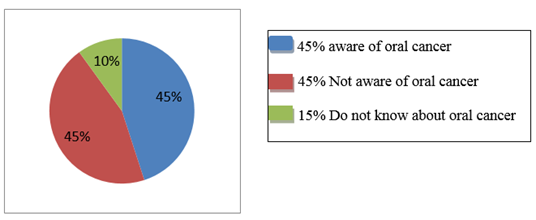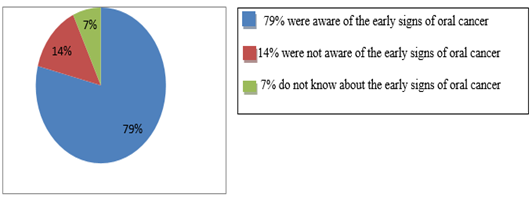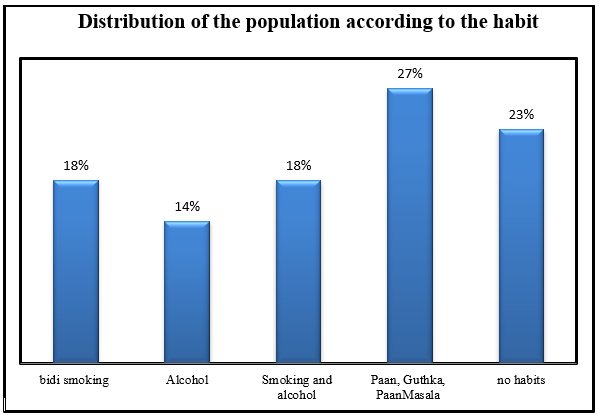Oral Cancer Awareness Among The General Public In Aligarh Of Uttar Pradesh Of India
Anshul Aggarwal1, Md. Asdullah2, Juhi Gupta2, Masood Hassan Khan2, Neha Aggarwal3
1 Associate Professor, Department of Oral Pathology/Oral Medicine &Radiology, Dr.Z.A Dental College & Hospital, A.M.U Aligarh (U.P), India.
2Assistant Professor, Department of Oral Pathology/Oral Medicine & Radiology, Dr.Z.A Dental College & Hospital, A.M.U Aligarh, India.
3Associate professor, Department of periodontics & Community Dentistry, Dr.Z.A Dental College & Hospital, A.M.U Aligarh, India.
|
|
Introduction
Cancer is a group of more than two hundreds of neoplastic diseases 1-3. It means an uncontrolled division of the abnormal tissue. It may invade the local tissue or may metastases to the distant organs through the lymphatic channel or blood vessel. Oral cancer originates from any part of the oral cavity and it may also arise from the tissue of oropharynx. Oral cancer is the sixth most common cancer worldwide. Uses of either smoke or smokeless tobacco, and alcohol consumption are the most common causes enlisted as the causative factor of oral cancer. Chronic trauma, genetics, HPV (human papillomavirus) infections, and malnutrition are other factors that may contribute to the development of oral cancer. Smoking and alcohol are found to have synergistic effects on the development of oral cancer. 4
The incidence of oral cancer is increasing worldwide and especially in India. The matter of concern is the increase in the number of young individuals developing oral cancer. The use of tobacco and alcohol is common all over the world and its impact on oral and general health is well documented. The use of smokeless tobacco and betel quid with or without tobacco are the major risk factors for oral cancer in India and its neighboring countries.5
Oral cancer is a preventable disease. But even after recent advances in oral diagnosis and treatment, oral cancer is getting diagnosed in a very late stage in most of the cases. As a result, prognosis and survival rates of oral cancer are <50% within 5 years. If oral cancer could be diagnosed in the early stage, the treatment outcome will be better with higher survival rates. But it all depends upon the awareness regarding oral cancer among the general public.6 The main barrier in the early detection of oral cancer is the lack of information about oral cancer in a dental patient. This fact has been confirmed by many researchers.7
After China and Brazil, India is the third-largest tobacco producer and most of the tobacco produced in India is getting consumed within the country 4. With this background, one study has been carried out to evaluate awareness about oral cancer among dental patients with the help of a self-administered structured questionnaire in the department of Oral Pathology/Oral Medicine and Radiology, Dr. Z.A. Dental College, AMU Aligarh.
Material and Method
The study was conducted on 500 subjects selected randomly from patients visiting OPD of Dr. Z.A. Dental College, AMU, Aligarh from January 2018 to August 2018. Ethical clearance was obtained from the institutional review board. Dental patients between the age group of 20-70 yrs who were willing to participate in the study were included in our study. Informed consent was obtained from the patients before the start of the study. Patients were provided with a self administered structured questionnaire. The questionnaire was in English and for patients who could not read English, the questions were translated into Hindi. The questionnaire consisted of 15 structured questions. Questions were related to the habit, risk factors associated with oral cancer, sign and symptoms, treatment cost, etc.
Questionnaire:
Awareness regarding oral cancer among dental patients
a. 20-30 yrs
b. 31-40 yrs
c. 41-50 yrs
d. 51-60yrs
e. 61-70 yrs
a. Illiterate
b. up to class V
c. 10+2 pass
d. Postgraduate or higher education
Yes ( )
No ( )
Don’t know ( )
Yes ( )
No ( )
Don’t know ( )
Yes ( )
No ( )
Don’t know ( )
Yes ( )
No ( )
Don’t know ( )
No ( )
Don’t know ( )
Yes ( )
No ( )
Don’t know ( )
Yes ( )
No ( )
Don’t know ( )
Yes ( )
No ( )
Don’t know ( )
Yes ( )
No ( )
Don’t know ( )
Yes ()
No ( )
Don’t know ( )
Results:
The data obtained have been tabulated and subjected to statistical analysis. For statistical analysis, SPPS Version 16 has been used. Descriptive analysis & Fisher’s exact test has been applied.
|
Questions |
Answers in percentage |
||||
|
365:135(73%:27%) |
||||
|
20-30 (31% = 155) |
31-40 (24% = 120) |
41-50 (18% = 90 |
51-60 (27%=135) |
61-70 (0% = 0) |
|
Illiterate (18%= 90) |
up to classV (23% = 115) |
10th pass (16% =80) |
Graduate/higher education (43% =215) |
|
|
Bidi smoking (18% = 90) |
Alcohol (14% =70) |
Smoking and alcohol (18%=90) |
Paan, Guthka, PaanMasala (27%=135) |
No habit (23% = 115) |
|
Yes (45% = 225) |
No (45% =225) |
Do not know (10% = 50) |
||
|
Yes (68% = 340) |
No (24%= 120) |
Do not know (08%=40 ) |
||
|
Yes (84% = 420) |
No (14%= 70) |
Do not know (2%=10) |
||
|
Yes (12%= 60) |
No (84%=420) |
Do not know (4%=20) |
||
|
Yes (15%= 75) |
No (77%=385) |
Do not know (8%=40) |
||
|
Yes (79%=395) |
No (14%=70) |
Do not know (7%=35) |
||
|
Yes (75% = 375) |
No (19% = 95) |
Do not know (6% = 30) |
||
|
Yes (13% =65) |
No (80%= 400) |
Do not know ( 8% = 40) |
||
|
Yes (15% =75) |
No (81%=405) |
Do not know (4% = 20) |
||
|
Yes (81%=405) |
No (15%=75) |
Do not know (4% = 20) |
||
|
Yes (88%= 440) |
No (9%=45) |
Do not know (3% = 15) |
||
Table 1. Questions with answers in percentage
The male to female ratio was 73:27 (Table 1). Most patients were teenagers between 20-30 years of age (Table 1). 41% of patients were either illiterate or had education up to class V or less than that. 16% of patients were 10th pass. 43% of patients were either graduate or had higher education (table 1). 18% of patients were using tobacco inform of bidi. 14% of patients had habit of alcohol drinking. 27% of patients were using guthka, paan, or paan masala. 18% of patients used to chew guthka and drink alcohol. 23% of the patients did not have any habit (figure 3). Interestly equal percentage, i.e. 45% of patients were aware and not aware of oral cancer (Table 1; figure1). Only 68% of patients were aware that drinking alcohol may also cause oral cancer (Table 1). 84% of patients were aware that the consumption of paan masala, paan, or guthka may cause oral cancer (Table 1). 84% of patients were aware that it is not an infectious disease or disease of old age (Table1). The majority (80%) of patients had no information regarding the prevention of oral cancer. Only 13% of patients were having information regarding prevention of oral cancer (Table 1). 79% patients were aware of the initial signs of oral cancer (Table 1; figure 2). 75% of patients were aware that oral cancer is treatable (table 1). The majority of patients i.e. 80% did not have adequate information regarding the prevention of oral cancer (table 1). 81% of patients were not exactly aware of the treatment cost (table 1). 81% of patients knew that if not treated, oral cancer may lead to death (table 1). 88%of people showed interest towards education and information regarding oral cancer (table 1).
|
E.D. |
Yes Number (%) |
No |
Don’t Know |
Total |
|
Illiterate Count |
0 (0%) .0% |
55 60.4% |
36 39.6% |
91 100.0% |
|
5thpassCount |
99 87.6% |
14 12.4% |
0 .0% |
113 100.0% |
|
10th pass Count |
81 100.0% |
0 .0% |
0 .0% |
81 100.0% |
|
Graduate and above Count |
215 100.0% |
0 .0% |
0 .0% |
215 100.0% |
|
Total Count |
395 79.0% |
69 13.8% |
36 7.2% |
500 100.0% |
P-value was significant at < 0.05%
Table 2. Association between education level and awareness regarding the early sign of oral cancer
|
Age range in yrs |
Yes |
No |
Don’t Know |
Total |
|
Count % within AGE range |
||||
|
155 |
0 |
0 |
155 |
|
Count % within AGE range |
100.0% |
.0% |
.0% |
100.0% |
|
120 |
0 |
0 |
120 |
|
Count % within AGE range |
100.0% |
.0% |
.0% |
100.0% |
|
90 |
0 |
0 |
90 |
|
Count % within AGE range |
100.0% |
.0% |
.0% |
100.0% |
|
4. 51-60 |
75 |
45 |
15 |
135 |
|
Count % within AGE range |
55.6% |
33.3% |
11.1% |
100.0% |
|
Total Count |
440 |
45 |
15 |
500 |
|
Count % within AGE range |
88.0% |
9.0% |
3.0% |
100.0% |
P value was significant at < 0.05%
Table 3. Association between the age and eagerness for education regarding oral cancer

Figure 1:Awareness of oral cancer among dental patients

Figure 2.Awareness of early sign of oral cancer among dental patients.

Figure 3. Distribution of the population according to the habit.
Discussion:
Oral cancer is a major public health problem in the Indian subcontinent, where it ranks among the top three types of cancer in the country 8. Tobacco is used in many forms in India. India is one of the leading countries in tobacco production and slowly it is becoming a leading country in terms of new cases of oral cancer. In rural areas or people belonging to low socioeconomic status, bidi smoking is the most common form of tobacco consumption. With the Hookah, chuttas, dhumti, chillum, cigars, cheroots, and pipes are some other forms of tobacco smoking in different parts of India 9. Introduction of guthka that usually consist of dried areca nut, tobacco and flavoring agent under the names such as paan masala, gutkha, and mawa is also popular in many parts of India.
This study has been carried out to know the awareness of general dental patients among Aligarh about oral cancer. In the study group, only 45% of patients were aware of oral cancer (figure 1) and most of them got information regarding the condition from electronic, printed, or social media. Very few of them got information regarding oral cancer from the dentist or any medical professional. This finding of our study is consistent with the findings of Park et al. 10 and Kumar et al. 11. This finding of our study emphasizes the importance of the role of digital media in creating awareness regarding oral cancer. It also indicates that people are obtaining information regarding health more from social and digital media rather than a physician or oral health professional.
In a country like India where oral health (especially in rural areas) has still not got much of importance and people do not approach a health professional until the pain is unbearable or an ulcer is persistent for months together it is really a great challenge for the health professionals to educate them regarding oral cancer. So, if digital media can do so, it must be used at its maximum potential.
Most of the patients who had guthka chewing habits or bidi smoking habits were daily wagers and belonged to low socioeconomic status. This finding is consistent with the findings of John 12. Guthka chewing was found to be more common in young adults. Most of the patient used to smoke bidi or chew guthka to increases the alertness and decreases their appetite. It thus helps them to work for long hours without having food or sleep.
Awareness regarding the initial signs of oral cancer was present in 79% of the study sample (figure 2). The finding of the study was in disagreement with the study done by Konduruet al.13 where the authors observed a very low percentage of patients who were aware of the early signs of oral cancer (like red or white lesion or a nonhealing ulcer). But this finding of our study was consistent with findings of Villa et al. 14 where awareness about early signs of oral cancer was high and 79.5% of patients knew that red or white lesions could be the early signs of oral cancer.
The awareness regarding the early signs of oral cancer was mostly confined to the educated people and the association between the education and awareness regarding the early sign of oral cancer has been found to be statistically significant (p-value < 0.05%) (Table 2). The finding of our study was consistent with the study done by Reddy et al. 15 and Al-Maweri et al. 16 This finding of our study emphasizes the importance of education in prevention and early diagnosis of oral cancer. Our eyes can see only what our mind knows. So, the general public must be made aware of the early signs of oral cancer.
Only 15% of patients were aware of the cost of the treatment, and 75% of patients were aware that it can be treated. Only 13% of patients were aware of the prevention of oral cancer. It shows that the general population has incomplete or partial information regarding the prevention and treatment of oral cancer.
88% of people accepted that they do not have much information and awareness regarding oral cancer and would be interested in getting information regarding the same (table 1). The eagerness to get information about oral cancer was found to be more in younger individuals and it was statistically significant (Table 3). It is one of the positive information obtained in the survey that dental patients were willing to get information regarding oral cancer and its prevention. Oral cancer is a deadly disease with a survival rate of ≤50% after 5 years 17. It greatly depends upon the stage at which it has been diagnosed, the anatomical site that has been involved, and early intervention once diagnosed.
Conclusion
Prevention is always better than cure. If we avoid the known etiological factors associated with oral cancer we can reduce the burden of oral cancer on the general population. The population in mass, especially those belonging to low socioeconomic status must be educated regarding the etiology and prevention of oral cancer. Oral cancer is treatable if diagnosed in the early stage but has a poor survival rate if diagnosed in an advanced stage. So being an oral health professional, it’s our moral responsibility to educate general dental patients, especially those having tobacco smoking or chewing habits about oral cancer.
References
www.thedailyrecords.com/2018...10.../largest-tobacco-producing-countries.../6876/
Jemal A, Brey F, Center M, et al (2011). Global cancer statistics.
CA: Cancer J Clin, 61, 69-90
Corresponding Author
Name Dr Anshul Aggarwal
Associate Professor, Department of Oral Pathology/Oral Medicine & Radiology, Dr.Z.A Dental College & Hospital, A.M.U Aligarh (U.P)
Email:draggarwal.xray @ gmail.com
Jemal A, Brey F, Center M, et al (2011). Global cancer statistics.
CA: Cancer J Clin, 61, 69-90
Jemal A, Brey F, Center M, et al (2011). Global cancer statistics.
CA: Cancer J Clin, 61, 69-90